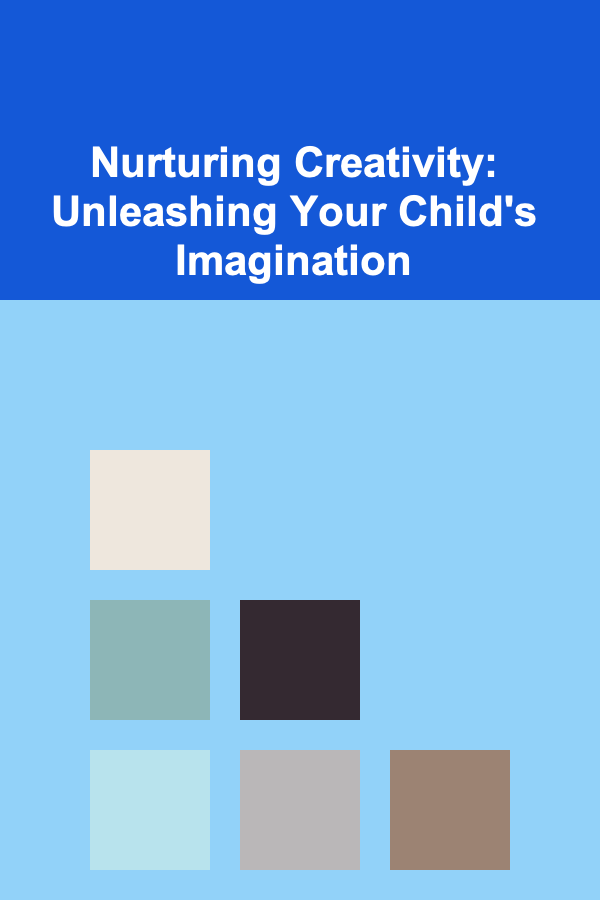
Nurturing Creativity: Unleashing Your Child's Imagination
ebook include PDF & Audio bundle (Micro Guide)
$12.99$10.99
Limited Time Offer! Order within the next:

Creativity is one of the most valuable assets a child can develop. It shapes their ability to problem-solve, think critically, and engage with the world in innovative ways. The ability to imagine and create is not only important for artistic expression but also fosters resilience, confidence, and a sense of independence. In a world that is rapidly evolving and demanding fresh ideas, nurturing a child's creativity can set the foundation for a successful future, both academically and personally.
However, many children, especially in their early years, may not immediately demonstrate creativity in ways that are conventionally recognized. For some, creativity may be expressed through art, while for others, it may manifest in a love for building things, solving problems, or creating stories. As parents, teachers, and mentors, it's crucial to understand how to recognize and nurture each child's unique creative abilities.
In this article, we will explore various strategies and methods that can help in fostering a child's creativity, allowing them to express themselves freely, develop innovative thinking, and cultivate a lifelong passion for imagination.
Understanding Creativity in Children
Creativity isn't just about producing artwork; it's a mindset and a process of exploration. For children, creativity is an essential component of their cognitive and emotional development. The earlier a child is encouraged to express themselves creatively, the more likely they are to build self-esteem, improve their problem-solving skills, and develop emotional intelligence.
Types of Creativity in Children
Creativity in children can be expressed in many different ways, and it's important to recognize that creativity is not limited to traditional artistic endeavors. Some of the key forms of creativity include:
- Artistic Creativity: Drawing, painting, sculpture, and any form of visual or performance art.
- Verbal Creativity: Storytelling, poetry, imaginative play, and writing.
- Logical Creativity: Problem-solving, puzzles, building things, and designing innovative solutions.
- Physical Creativity: Dance, sports, and movement-based activities that allow a child to express creativity through their bodies.
By recognizing these various forms, caregivers and educators can better support children in finding their own outlets for creativity.
The Importance of Fostering Creativity
Creativity is more than just a fun activity; it has far-reaching benefits that extend well beyond childhood. In fact, fostering creativity can positively influence a child's intellectual, emotional, and social development.
Intellectual Growth
Creative activities encourage critical thinking and problem-solving. Whether it's finding a new way to complete a puzzle or inventing a game, children learn to think outside the box. This not only boosts cognitive development but also helps improve their ability to analyze, reason, and evaluate information in all aspects of life.
Emotional Intelligence
Creative activities help children explore and express their emotions in healthy ways. Art, music, or imaginative play can be an outlet for frustration, joy, sadness, or excitement. Children who have a creative outlet are better able to understand and regulate their emotions, which can lead to higher self-esteem and improved mental well-being.
Social Skills and Collaboration
Group creative activities, such as building a fort with friends, painting a mural, or putting on a play, teach children how to collaborate and communicate with others. These shared creative experiences help them develop teamwork skills, empathy, and the ability to share ideas and resources with peers.
Resilience and Confidence
When children engage in creative activities, they often face challenges---whether it's figuring out how to bring their vision to life or overcoming frustration when things don't go as planned. Through trial and error, children learn to be persistent, adaptable, and resilient. Completing a creative project, even with its ups and downs, helps to build a child's self-confidence and sense of accomplishment.
Providing a Creative Environment
The environment in which a child is raised plays a critical role in fostering creativity. A creative space doesn't necessarily need to be filled with fancy toys or expensive materials. What matters most is providing children with the time, resources, and encouragement to explore their creative potential.
Physical Space for Creativity
Create a dedicated space in the home where children can freely express their creativity. This space should be filled with materials that encourage exploration, such as art supplies, construction toys, musical instruments, or building blocks. The key is to make sure that the space is open-ended and adaptable to different types of creative activities. The space should feel welcoming and allow children to immerse themselves in their projects without feeling rushed or restricted.
Open-Ended Materials
Children's creativity thrives when they have access to materials that allow for multiple uses and interpretations. Rather than giving them a pre-assembled kit with a specific outcome, provide open-ended materials that encourage them to think creatively. For example:
- Art Supplies: Paints, crayons, markers, paper, clay, or fabric allow children to create in any way they wish.
- Building Materials: Blocks, LEGO sets, or natural materials like sticks, stones, and sand can be used for constructing everything from simple structures to complex inventions.
- Musical Instruments: Drums, tambourines, and xylophones allow children to experiment with rhythm and sound.
Time for Creative Exploration
Creativity doesn't always emerge under time constraints. For children to truly engage their imaginations, they need time to explore and experiment without pressure. Set aside dedicated time for creative activities and give your child the freedom to take the lead in their projects.
Encouraging Creative Thinking
Fostering a child's creativity is not just about providing the right environment and tools; it's also about encouraging and nurturing creative thinking. Here are some strategies to help children unlock their imagination:
Ask Open-Ended Questions
Rather than offering solutions, ask questions that prompt your child to think critically and explore different possibilities. For example:
- "What would happen if...?"
- "How do you think we could solve this problem in a different way?"
- "What would you do if you were a character in this story?"
These types of questions stimulate curiosity and allow children to think outside the box. The more questions you ask, the more your child's mind will be stimulated to think creatively.
Provide Opportunities for Imaginative Play
Imaginative play is one of the best ways to encourage creativity in children. Whether it's pretending to be superheroes, explorers, or artists, imaginative play allows children to build new worlds, experiment with different roles, and explore their feelings. Encourage this type of play by providing props like costumes, puppets, or a simple box that can be turned into a spaceship, castle, or secret lair.
Embrace Failure and Mistakes
Creativity often involves making mistakes and learning from them. It's important to help children understand that failure is part of the creative process. Rather than discouraging a child when something doesn't work out, celebrate their efforts and encourage them to try again. Over time, they will develop resilience and a growth mindset, which are essential for cultivating creativity.
Model Creativity
Children learn by observing the adults around them. If they see you engaged in creative activities, whether it's writing, painting, cooking, or solving problems in innovative ways, they are more likely to develop an interest in exploring their own creative potential. Set an example by engaging in creative activities and sharing the joy of creating with your child.
Supporting Creativity through Education
Education plays a significant role in shaping a child's creative development. While traditional education systems often prioritize academic skills like reading, writing, and math, it's important to find ways to support creative development within this structure.
Integrating Creative Subjects
Incorporating creative subjects into the child's learning experience can help balance the structure of academic subjects. Encourage your child to participate in art, music, drama, or dance classes. Even activities like science experiments, cooking, or gardening can be creative, hands-on learning experiences that stimulate a child's imagination.
Encourage Problem-Solving and Critical Thinking
Children learn to be creative when they are encouraged to solve problems independently. Present them with challenges or puzzles that require creative thinking. For example, give them a pile of random objects and ask them to create something new from them. This will help them practice thinking critically and outside the box.
Provide Freedom within Structure
While structure is important for academic success, children need the freedom to explore their own interests and passions within this framework. Encourage them to pursue creative projects related to their personal interests, even if it's not directly tied to schoolwork. This allows them to take ownership of their learning and express themselves in meaningful ways.
Fostering Lifelong Creativity
Creativity is a lifelong skill, and its development doesn't stop when childhood ends. By nurturing a child's creativity early on, you are giving them the tools they need to think critically, adapt to change, and continue innovating throughout their lives.
Encourage Curiosity
Fostering a love of learning and curiosity is one of the best ways to ensure that creativity continues to grow throughout life. Encourage your child to ask questions, seek new experiences, and be open to exploring new ideas.
Provide Exposure to Different Cultures and Ideas
Expose your child to diverse cultures, art forms, literature, and ways of thinking. This exposure will broaden their horizons and inspire them to think creatively. Whether through travel, books, or media, new perspectives can spark fresh ideas and encourage creative thinking.
Keep the Creative Spirit Alive
Even as children grow older, it's important to maintain their creative engagement. Encourage them to participate in hobbies, take on new creative challenges, and continue exploring new outlets for their creativity. Creativity doesn't just have to be a childhood pursuit---it can be a lifelong passion.
Conclusion
Creativity is a powerful tool that shapes a child's development and opens up endless possibilities for their future. By creating an environment that encourages imagination, providing the right resources, and supporting their creative expression, we can help children unleash their full creative potential. The benefits of fostering creativity extend far beyond childhood, impacting their intellectual, emotional, and social development. Ultimately, nurturing creativity equips children with the skills they need to thrive in an ever-changing world, and it's one of the most valuable gifts we can offer them.

How to Brew Coffee in a French Press: Advanced Techniques
Read More
How to Maintain Your Seasonal Wardrobe with Care
Read More
How to Navigate Financial Stress and Stay Focused on Your Goals
Read More
How to Optimize Bathroom Storage with Creative Solutions
Read More
How to Stage a Home to Sell During the Winter Season
Read More
Saving on Home Energy Bills: A Complete Guide to Reducing Your Monthly Expenses
Read MoreOther Products

How to Brew Coffee in a French Press: Advanced Techniques
Read More
How to Maintain Your Seasonal Wardrobe with Care
Read More
How to Navigate Financial Stress and Stay Focused on Your Goals
Read More
How to Optimize Bathroom Storage with Creative Solutions
Read More
How to Stage a Home to Sell During the Winter Season
Read More